Comparative Analysis of Data-Driven Algorithms for Building Energy Planning via Federated Learning
Abstract
:1. Introduction
2. Literature Review
3. Comparative Analysis
3.1. Data Driven Algorithms
3.1.1. ANN
3.1.2. LSTM
3.1.3. CNN
3.1.4. Bidirectional LSTM
3.1.5. CNN and LSTM
3.1.6. GRU
3.2. Federated Learning
4. Experiments
4.1. Data Description
4.2. Implementation
4.3. Evaluation Results
5. Discussion and Future Work
6. Conclusions
Author Contributions
Funding
Data Availability Statement
Conflicts of Interest
Abbreviations
| AI | Artificial Intelligence |
| ANN | Artificial Neural Network |
| CL | Centralized Learning |
| CNN | Convolutional Neural Network |
| DL | Deep Learning |
| FL | Federated Learning |
| GB | Gradient Boosting |
| GDPR | General Data Protection Regulation |
| GHG | Greenhouse gas |
| GRU | Gated Recurrent Unit |
| HVAC | Heating, Ventilation and Air Conditioning |
| IoT | Internet of Things |
| LSTM | Long Sort-term Memory |
| MAE | Mean Absolute Error |
| MAPE | Mean Absolute Percentage Error |
| ML | Machine Learning |
| MSE | Mean Square Error |
| ReLU | Rectified Linear Unit |
| RF | Random Forest |
| RNN | Recurrent Neural Network |
| SVM | Support Vector Machine |
Appendix A
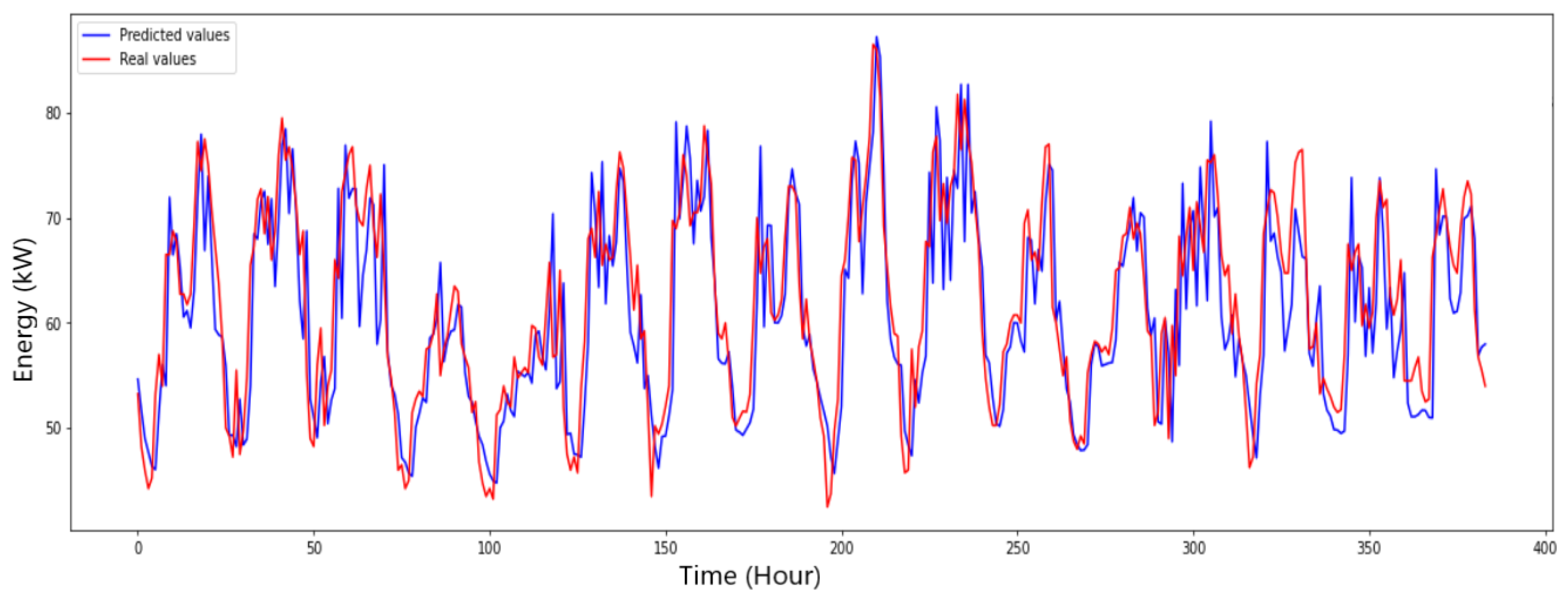
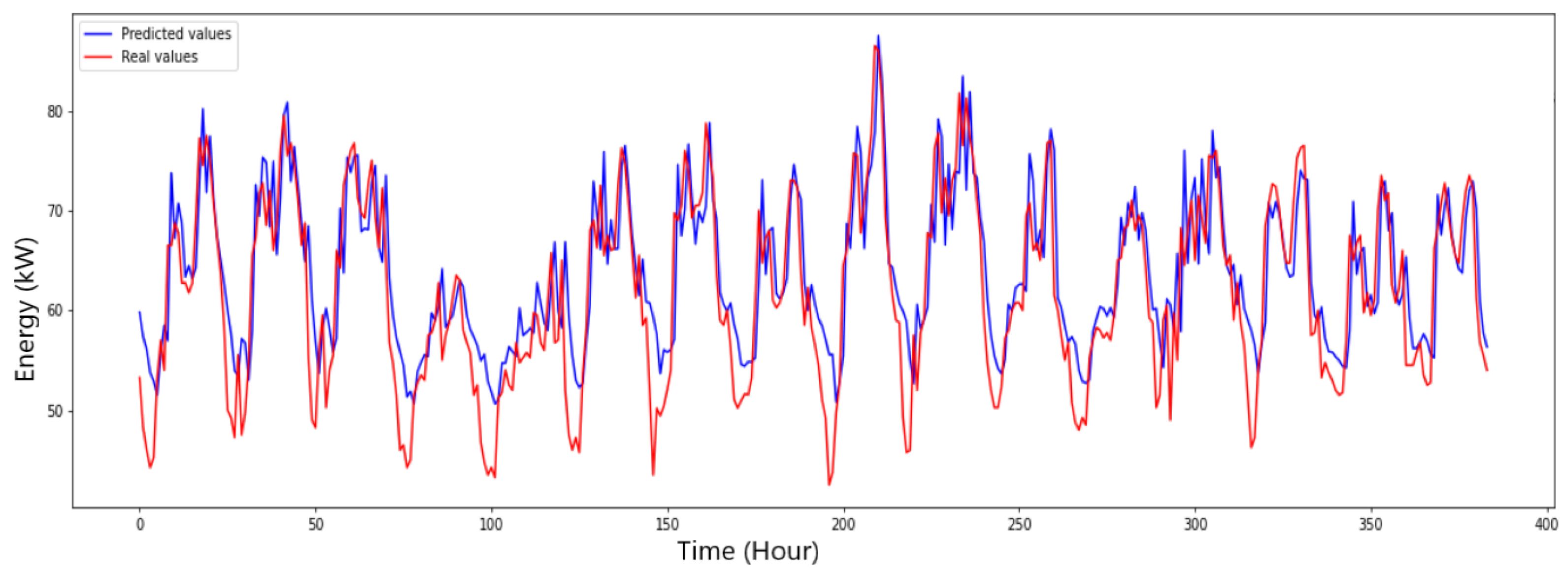

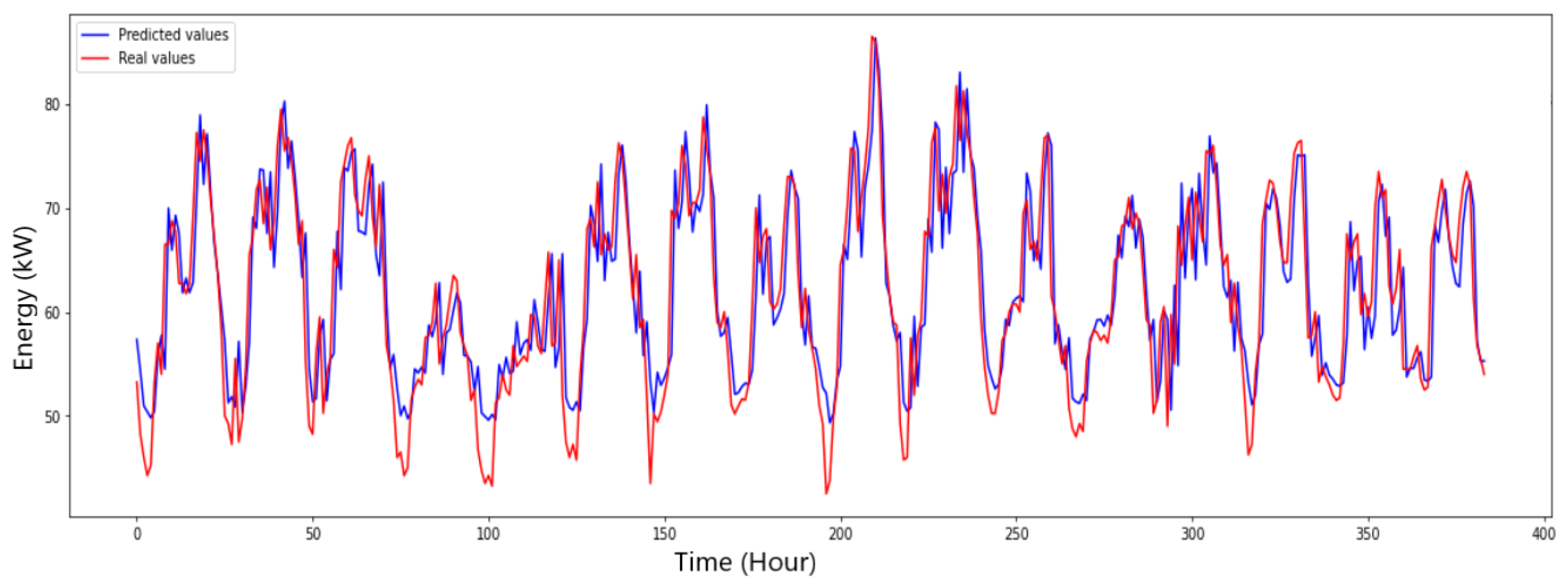
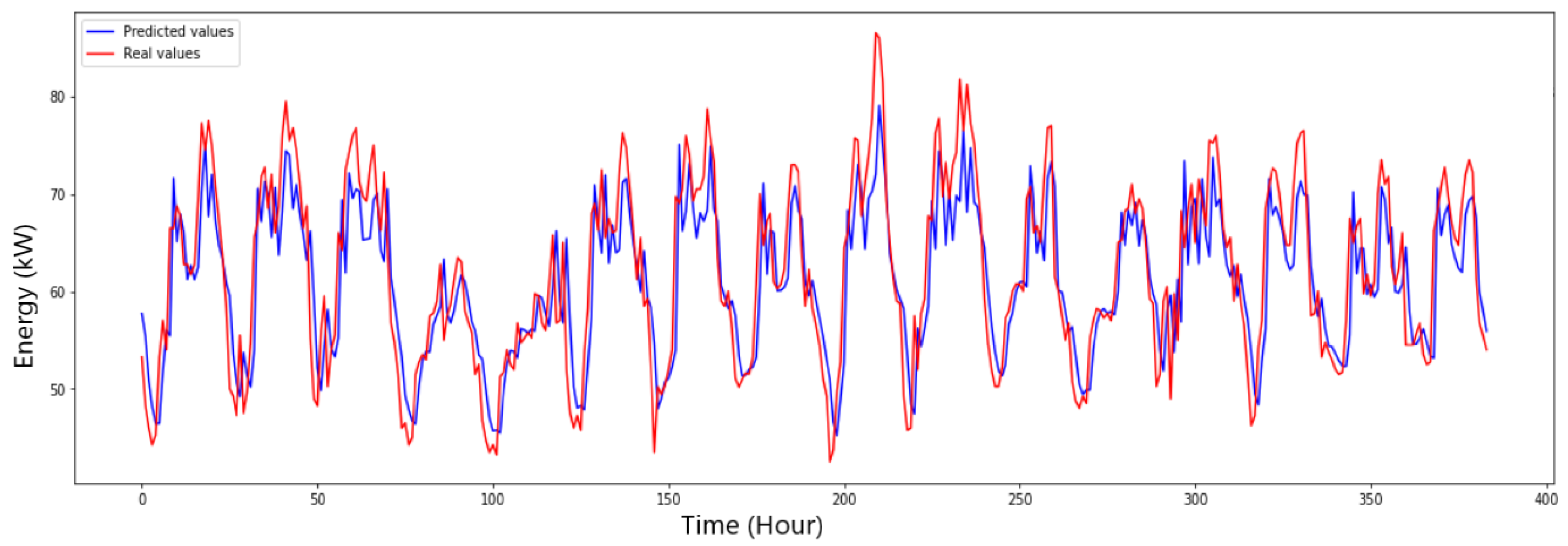
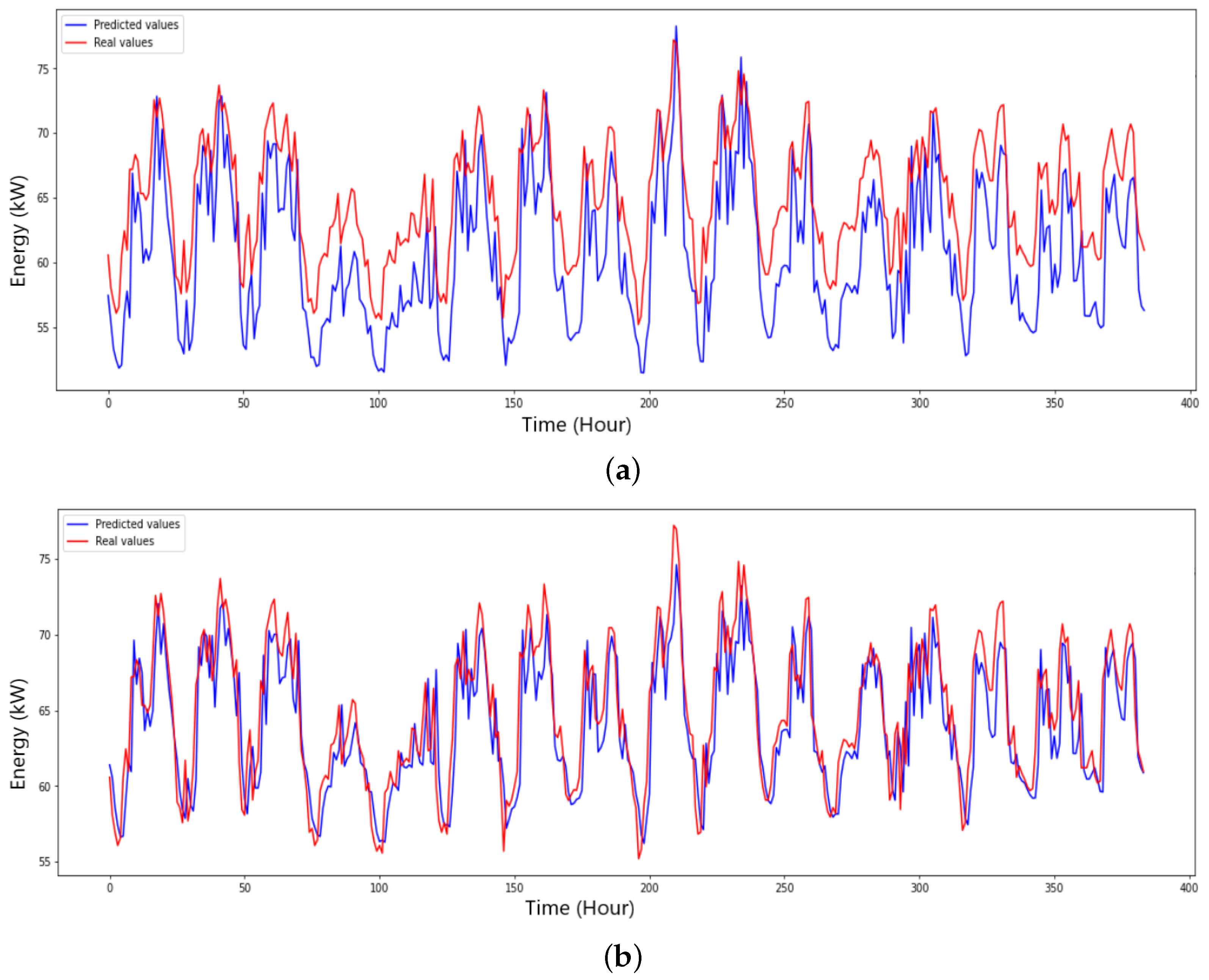
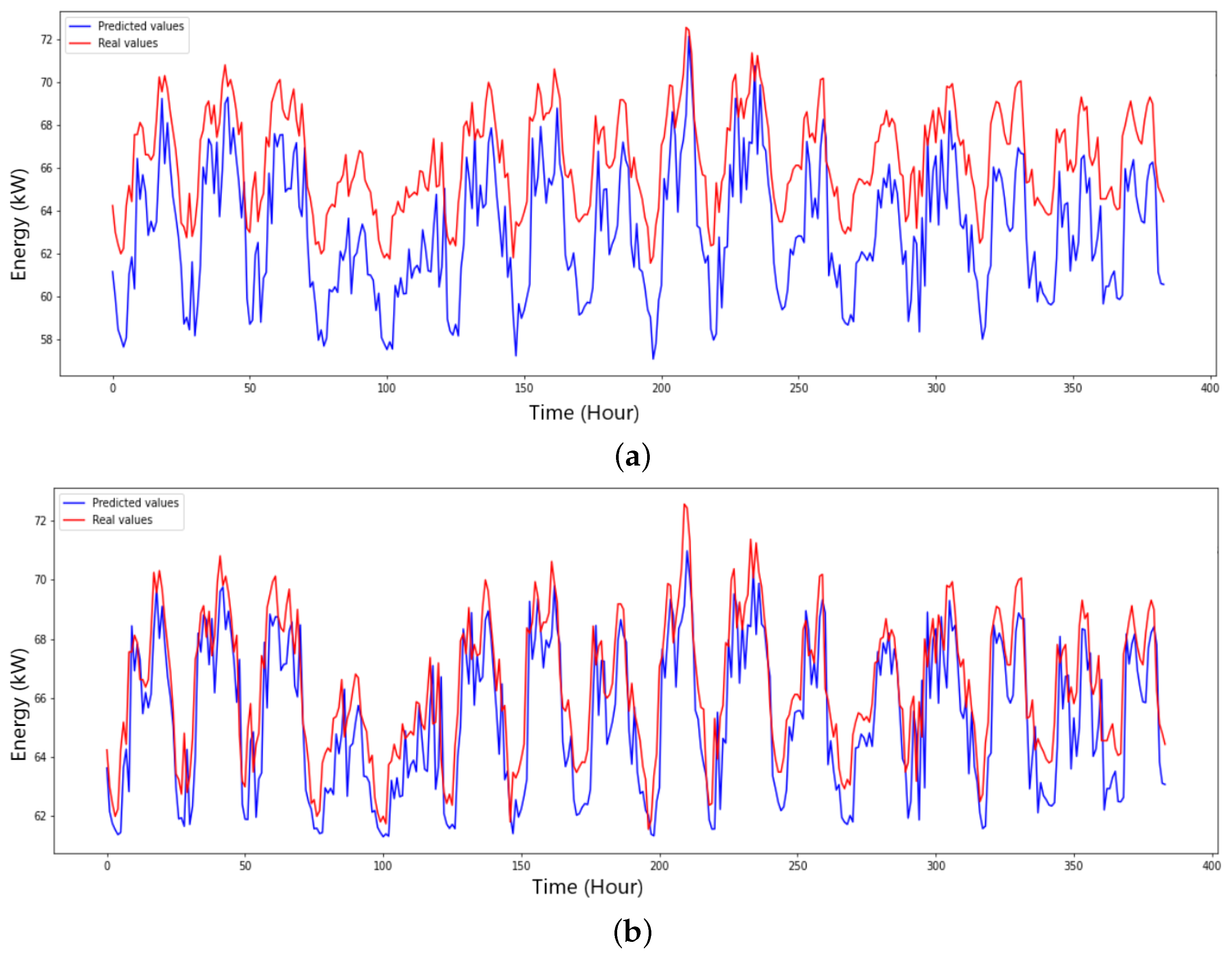
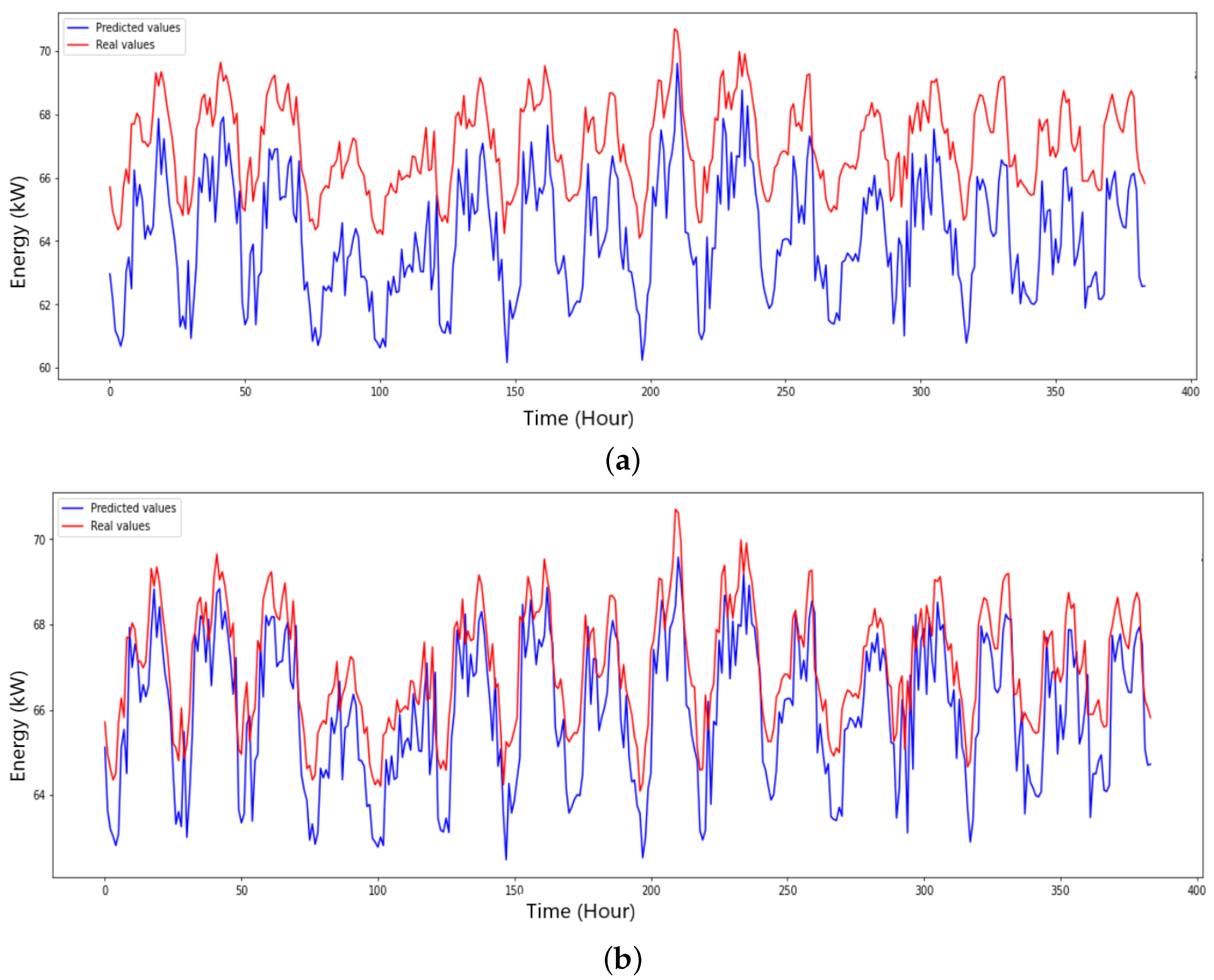
References
- Ren, Y.Y.; Ren, G.Y.; Sun, X.B.; Shrestha, A.B.; You, Q.L.; Zhan, Y.J.; Rajbhandari, R.; Zhang, P.F.; Wen, K.M. Observed changes in surface air temperature and precipitation in the Hindu Kush Himalayan region over the last 100-plus years. Adv. Clim. Chang. Res. 2017, 8, 148–156. [Google Scholar] [CrossRef]
- Khalil, M.; McGough, A.S.; Pourmirza, Z.; Pazhoohesh, M.; Walker, S. Machine Learning, Deep Learning and Statistical Analysis for forecasting building energy consumption—A systematic review. Eng. Appl. Artif. Intell. 2022, 115, 105287. [Google Scholar] [CrossRef]
- Ohene, E.; Chan, A.P.; Darko, A. Prioritizing barriers and developing mitigation strategies toward net-zero carbon building sector. Build. Environ. 2022, 223, 109437. [Google Scholar] [CrossRef]
- Dong, B.; Prakash, V.; Feng, F.; O’Neill, Z. A review of smart building sensing system for better indoor environment control. Energy Build. 2019, 199, 29–46. [Google Scholar] [CrossRef]
- Olu-Ajayi, R.; Alaka, H.; Sulaimon, I.; Sunmola, F.; Ajayi, S. Building energy consumption prediction for residential buildings using deep learning and other machine learning techniques. J. Build. Eng. 2022, 45, 103406. [Google Scholar] [CrossRef]
- Colmenar-Santos, A.; de Lober, L.N.T.; Borge-Diez, D.; Castro-Gil, M. Solutions to reduce energy consumption in the management of large buildings. Energy Build. 2013, 56, 66–77. [Google Scholar] [CrossRef]
- Konečnỳ, J.; McMahan, H.B.; Yu, F.X.; Richtárik, P.; Suresh, A.T.; Bacon, D. Federated learning: Strategies for improving communication efficiency. arXiv 2016, arXiv:1610.05492. [Google Scholar]
- Runge, J.; Zmeureanu, R. Forecasting energy use in buildings using artificial neural networks: A review. Energies 2019, 12, 3254. [Google Scholar] [CrossRef]
- Mahapatra, B.; Nayyar, A. Home energy management system (HEMS): Concept, architecture, infrastructure, challenges and energy management schemes. Energy Syst. 2022, 13, 643–669. [Google Scholar] [CrossRef]
- Zafar, U.; Bayhan, S.; Sanfilippo, A. Home energy management system concepts, configurations, and technologies for the smart grid. IEEE Access 2020, 8, 119271–119286. [Google Scholar] [CrossRef]
- Marikyan, D.; Papagiannidis, S.; Alamanos, E. A systematic review of the smart home literature: A user perspective. Technol. Forecast. Soc. Chang. 2019, 138, 139–154. [Google Scholar] [CrossRef]
- Harish, V.; Kumar, A. A review on modeling and simulation of building energy systems. Renew. Sustain. Energy Rev. 2016, 56, 1272–1292. [Google Scholar] [CrossRef]
- Pham, A.D.; Ngo, N.T.; Truong, T.T.H.; Huynh, N.T.; Truong, N.S. Predicting energy consumption in multiple buildings using machine learning for improving energy efficiency and sustainability. J. Clean. Prod. 2020, 260, 121082. [Google Scholar] [CrossRef]
- Petrangeli, E.; Tonellotto, N.; Vallati, C. Performance Evaluation of Federated Learning for Residential Energy Forecasting. IoT 2022, 3, 381–397. [Google Scholar] [CrossRef]
- Shi, Y.; Xu, X. Deep Federated Adaptation: An Adaptative Residential Load Forecasting Approach with Federated Learning. Sensors 2022, 22, 3264. [Google Scholar] [CrossRef] [PubMed]
- Sater, R.A.; Hamza, A.B. A federated learning approach to anomaly detection in smart buildings. ACM Trans. Internet Things 2021, 2, 1–23. [Google Scholar] [CrossRef]
- Dutta, G.; Mitra, K. A literature review on dynamic pricing of electricity. J. Oper. Res. Soc. 2017, 68, 1131–1145. [Google Scholar] [CrossRef]
- Gupta, A.; Gupta, H.P.; Das, S.K. FedAR+: A Federated Learning Approach to Appliance Recognition with Mislabeled Data in Residential Buildings. arXiv 2022, arXiv:2209.01338. [Google Scholar]
- Gao, J.; Wang, W.; Liu, Z.; Billah, M.F.R.M.; Campbell, B. Decentralized federated learning framework for the neighborhood: A case study on residential building load forecasting. In Proceedings of the 19th ACM Conference on Embedded Networked Sensor Systems, Coimbra, Portugal, 15–17 November 2021; pp. 453–459. [Google Scholar]
- Gholizadeh, N.; Musilek, P. Federated learning with hyperparameter-based clustering for electrical load forecasting. Internet Things 2022, 17, 100470. [Google Scholar] [CrossRef]
- Husnoo, M.A.; Anwar, A.; Hosseinzadeh, N.; Islam, S.N.; Mahmood, A.N.; Doss, R. FedREP: Towards Horizontal Federated Load Forecasting for Retail Energy Providers. arXiv 2022, arXiv:2203.00219. [Google Scholar]
- Taïk, A.; Cherkaoui, S. Electrical load forecasting using edge computing and federated learning. In Proceedings of the ICC 2020-2020 IEEE International Conference on Communications (ICC), Virtual, 7–11 June 2020; pp. 1–6. [Google Scholar]
- Briggs, C.; Fan, Z.; Andras, P. Federated Learning for Short-term Residential Load Forecasting. IEEE Open Access J. Power Energy 2022, 9, 573–583. [Google Scholar] [CrossRef]
- Tang, L.; Xie, H.; Wang, X.; Bie, Z. Privacy-preserving knowledge sharing for few-shot building energy prediction: A federated learning approach. Appl. Energy 2023, 337, 120860. [Google Scholar] [CrossRef]
- Dogra, A.; Anand, A.; Bedi, J. Consumers profiling based federated learning approach for energy load forecasting. Sustain. Cities Soc. 2023, 98, 104815. [Google Scholar] [CrossRef]
- Li, J.; Zhang, C.; Zhao, Y.; Qiu, W.; Chen, Q.; Zhang, X. Federated learning-based short-term building energy consumption prediction method for solving the data silos problem. Build. Simul. 2022, 15, 1145–1159. [Google Scholar] [CrossRef]
- Badr, M.M.; Ibrahem, M.I.; Mahmoud, M.; Alasmary, W.; Fouda, M.M.; Almotairi, K.H.; Fadlullah, Z.M. Privacy-preserving federated-learning-based net-energy forecasting. In Proceedings of the SoutheastCon 2022, Mobile, AL, USA, 26 March–3 April 2022; pp. 133–139. [Google Scholar]
- Wang, F.; Cen, J.; Yu, Z.; Deng, S.; Zhang, G. Research on a hybrid model for cooling load prediction based on wavelet threshold denoising and deep learning: A study in China. Energy Rep. 2022, 8, 10950–10962. [Google Scholar] [CrossRef]
- Alrasheedi, A.; Almalaq, A. Hybrid Deep Learning Applied on Saudi Smart Grids for Short-Term Load Forecasting. Mathematics 2022, 10, 2666. [Google Scholar] [CrossRef]
- Khortsriwong, N.; Boonraksa, P.; Boonraksa, T.; Fangsuwannarak, T.; Boonsrirat, A.; Pinthurat, W.; Marungsri, B. Performance of Deep Learning Techniques for Forecasting PV Power Generation: A Case Study on a 1.5 MWp Floating PV Power Plant. Energies 2023, 16, 2119. [Google Scholar] [CrossRef]
- Zhen, H.; Niu, D.; Yu, M.; Wang, K.; Liang, Y.; Xu, X. A hybrid deep learning model and comparison for wind power forecasting considering temporal-Spatial feature extraction. Sustainability 2020, 12, 9490. [Google Scholar] [CrossRef]
- Abiodun, O.I.; Jantan, A.; Omolara, A.E.; Dada, K.V.; Mohamed, N.A.; Arshad, H. State-of-the-art in artificial neural network applications: A survey. Heliyon 2018, 4, e00938. [Google Scholar] [CrossRef]
- Van Houdt, G.; Mosquera, C.; Nápoles, G. A review on the long short-term memory model. Artif. Intell. Rev. 2020, 53, 5929–5955. [Google Scholar] [CrossRef]
- Gu, J.; Wang, Z.; Kuen, J.; Ma, L.; Shahroudy, A.; Shuai, B.; Liu, T.; Wang, X.; Wang, G.; Cai, J.; et al. Recent advances in convolutional neural networks. Pattern Recognit. 2018, 77, 354–377. [Google Scholar] [CrossRef]
- Peng, T.; Zhang, C.; Zhou, J.; Nazir, M.S. An integrated framework of Bi-directional long-short term memory (BiLSTM) based on sine cosine algorithm for hourly solar radiation forecasting. Energy 2021, 221, 119887. [Google Scholar] [CrossRef]
- Tian, C.; Ma, J.; Zhang, C.; Zhan, P. A deep neural network model for short-term load forecast based on long short-term memory network and convolutional neural network. Energies 2018, 11, 3493. [Google Scholar] [CrossRef]
- Ke, K.; Hongbin, S.; Chengkang, Z.; Brown, C. Short-term electrical load forecasting method based on stacked auto-encoding and GRU neural network. Evol. Intell. 2019, 12, 385–394. [Google Scholar] [CrossRef]
- Nguyen, D.C.; Ding, M.; Pathirana, P.N.; Seneviratne, A.; Li, J.; Poor, H.V. Federated learning for internet of things: A comprehensive survey. IEEE Commun. Surv. Tutor. 2021, 23, 1622–1658. [Google Scholar] [CrossRef]
- Miller, C.; Kathirgamanathan, A.; Picchetti, B.; Arjunan, P.; Park, J.Y.; Nagy, Z.; Raftery, P.; Hobson, B.W.; Shi, Z.; Meggers, F. The building data genome project 2, energy meter data from the ASHRAE great energy predictor III competition. Sci. Data 2020, 7, 1–13. [Google Scholar] [CrossRef] [PubMed]
- Ali, M.; Wazir, R.; Imran, K.; Ullah, K.; Janjua, A.K.; Ulasyar, A.; Khattak, A.; Guerrero, J.M. Techno-economic assessment and sustainability impact of hybrid energy systems in Gilgit-Baltistan, Pakistan. Energy Rep. 2021, 7, 2546–2562. [Google Scholar] [CrossRef]
- Ziosi, M.; Hewitt, B.; Juneja, P.; Taddeo, M.; Floridi, L. Smart cities: Reviewing the debate about their ethical implications. AI Soc. 2022. [Google Scholar] [CrossRef]
- Pandya, S.; Srivastava, G.; Jhaveri, R.; Babu, M.R.; Bhattacharya, S.; Maddikunta, P.K.R.; Mastorakis, S.; Piran, M.J.; Gadekallu, T.R. Federated learning for smart cities: A comprehensive survey. Sustain. Energy Technol. Assess. 2023, 55, 102987. [Google Scholar] [CrossRef]

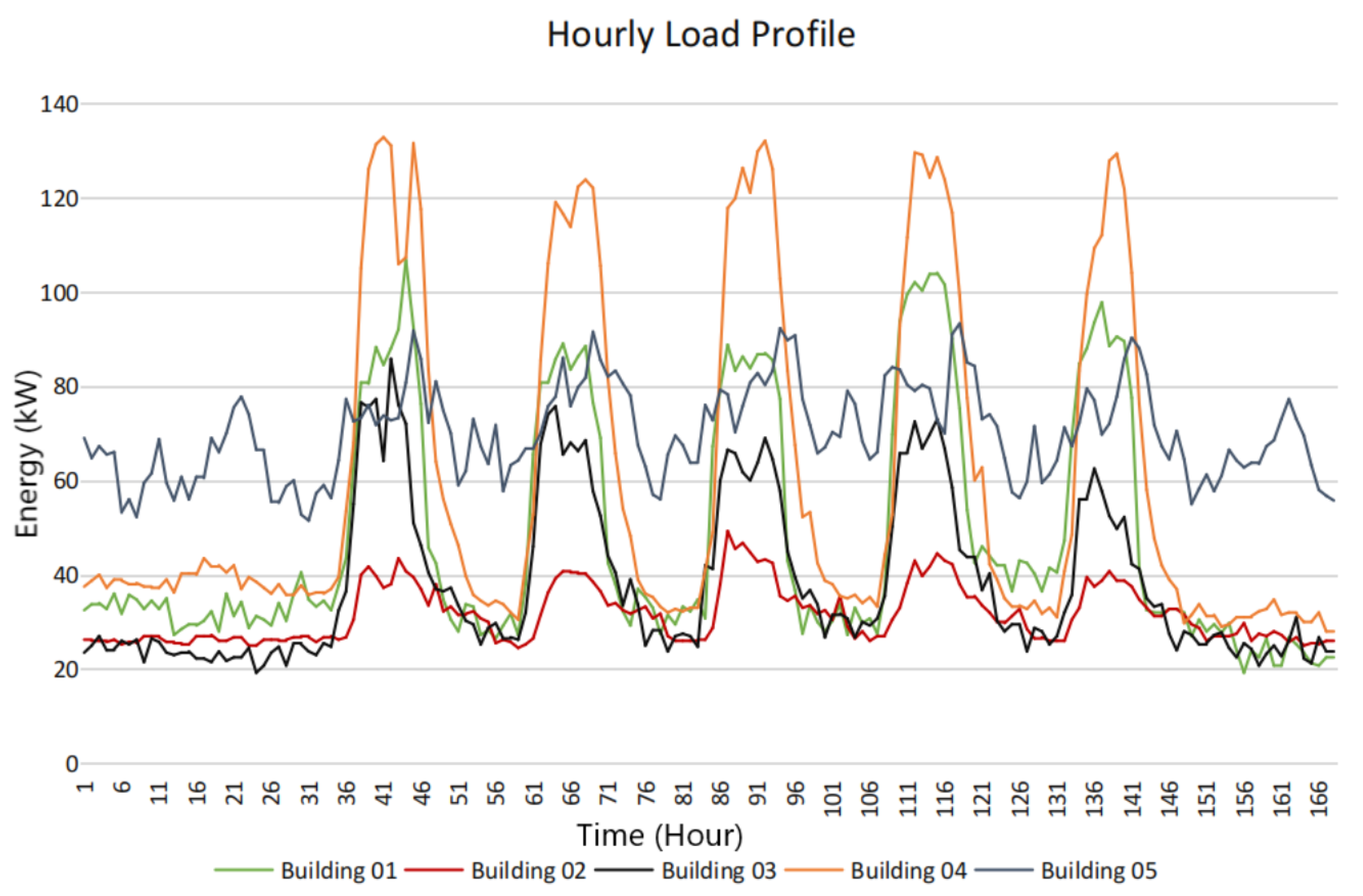
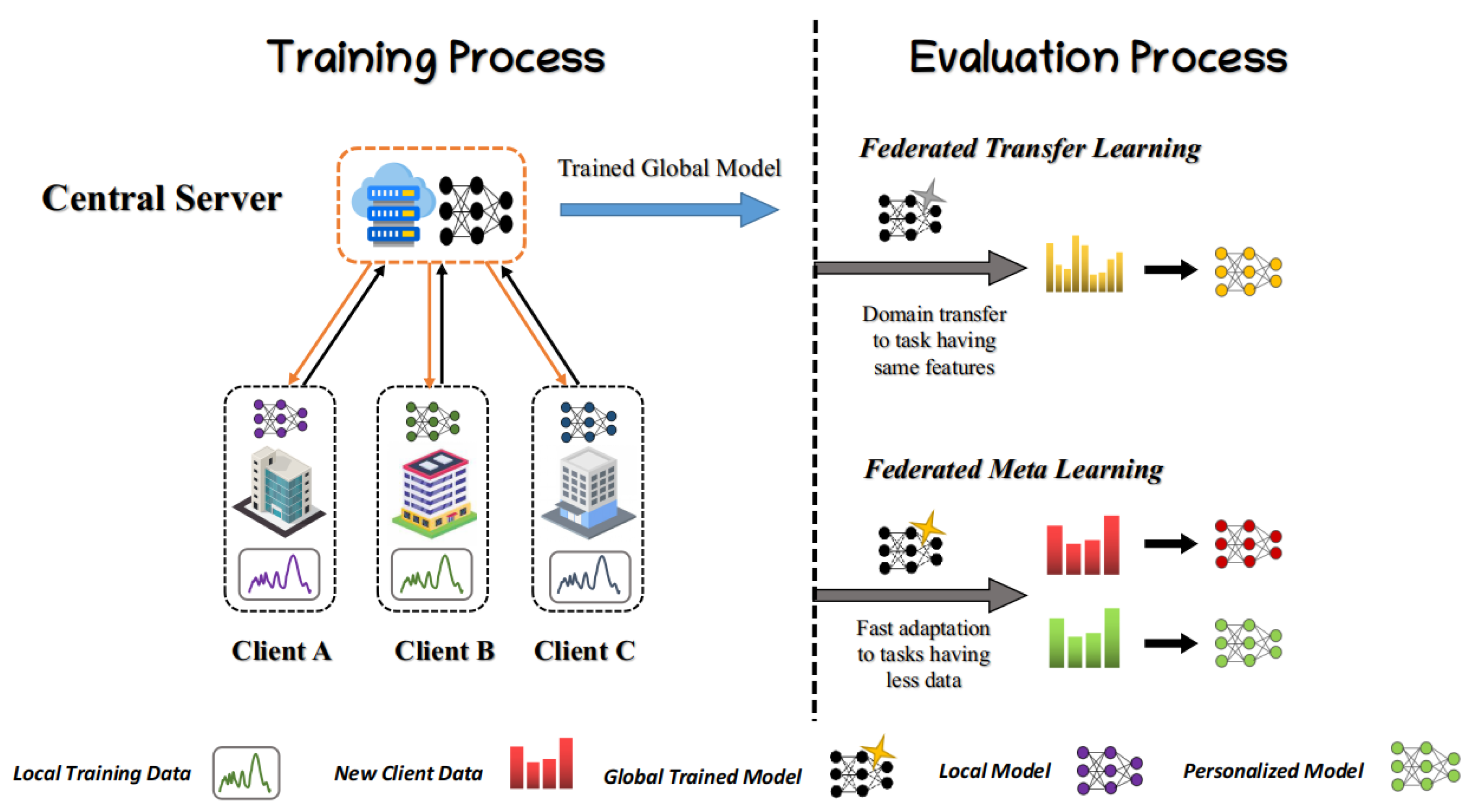
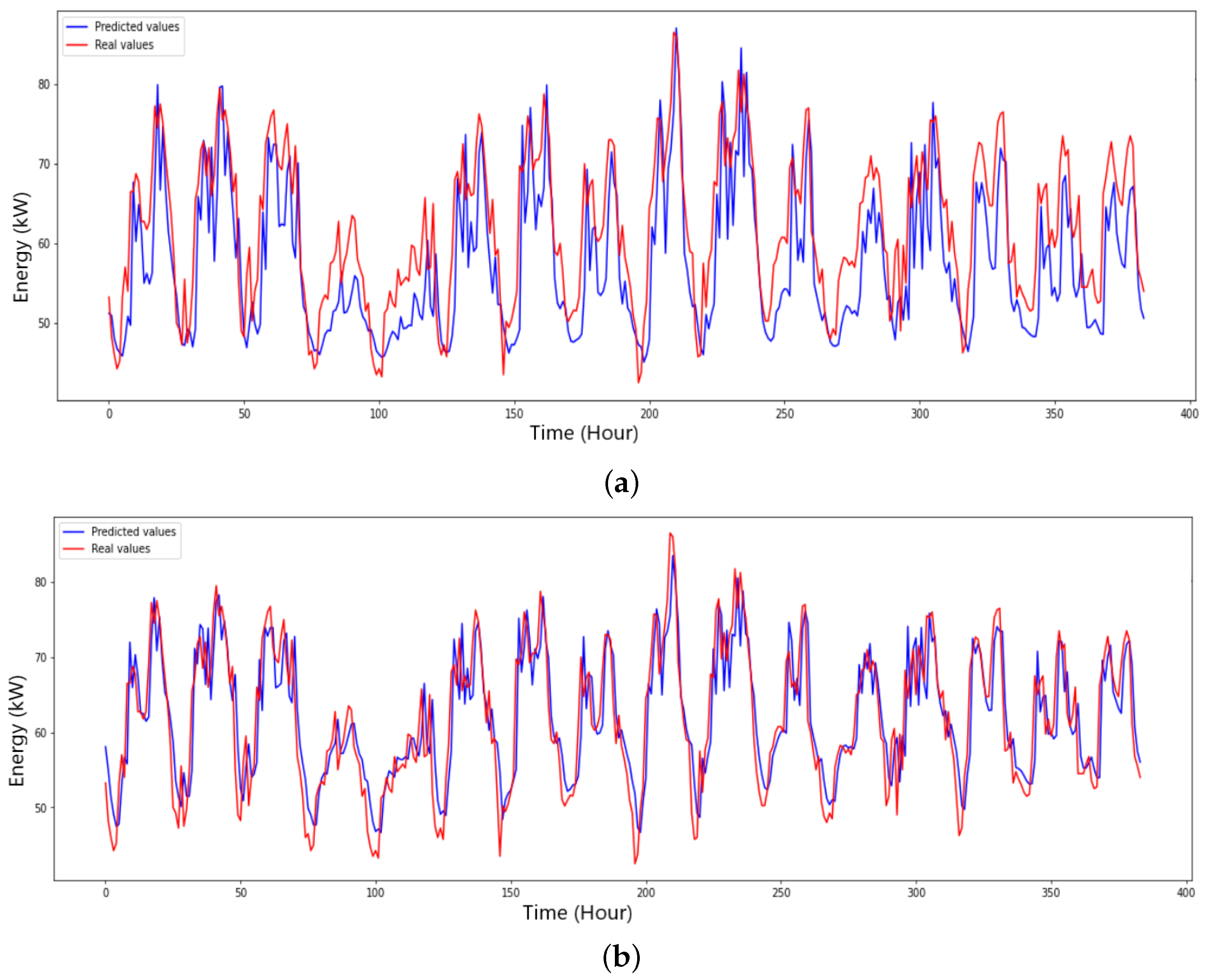
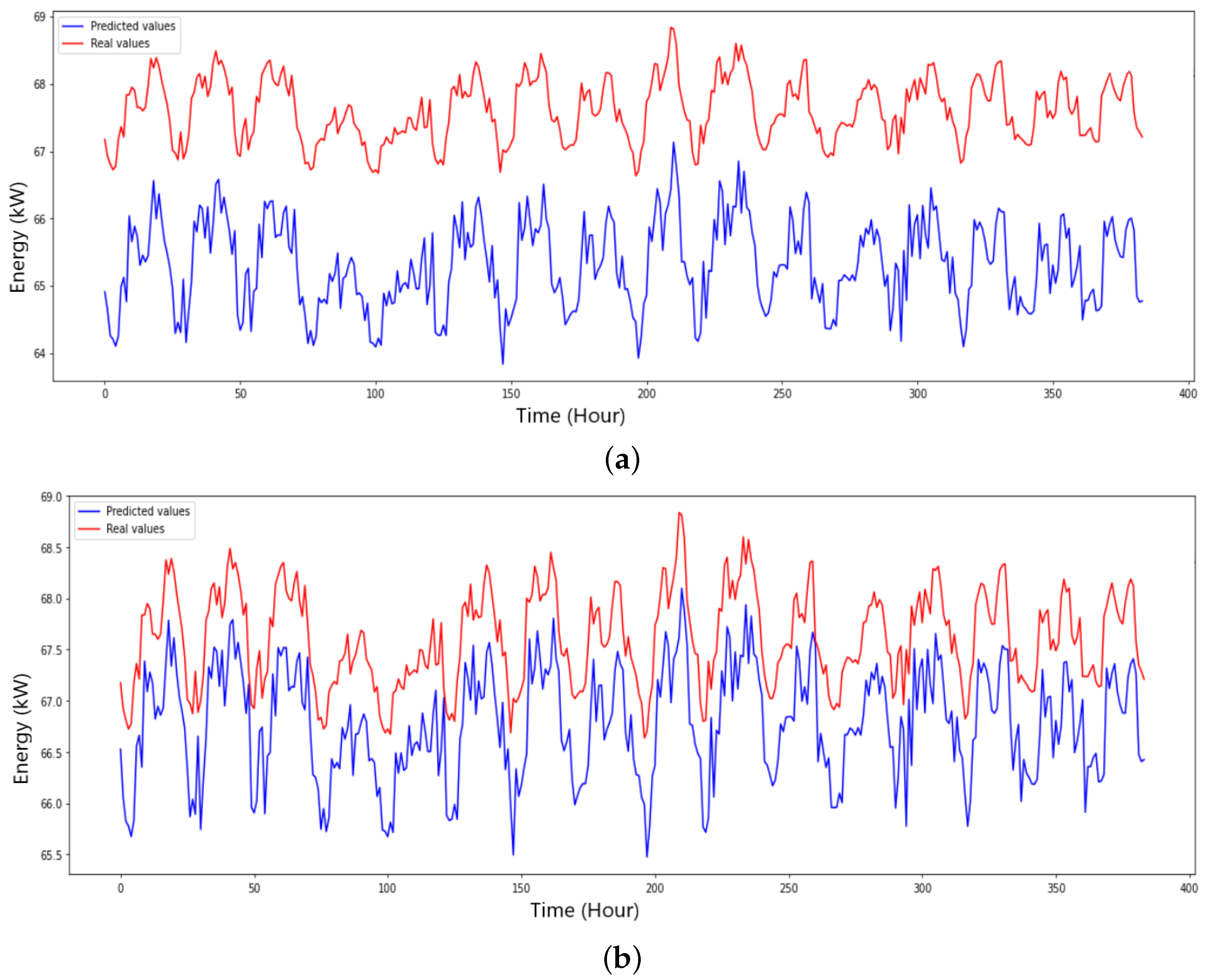
| Attributes Category | Attributes Type |
|---|---|
| Temporal | Day Type, Hour |
| Meteorological | Outdoor Air Temperature, Outdoor Relative Humidity |
| Building structure | Number of Floors, Gross Floor Area, Construction Year |
| Consumption-related | Energy Utilization in Previous Hour |
| Hyperparameters | Search Space | Value |
|---|---|---|
| No. of Neurons | 10, 20, 30, 50 | 10 |
| Activation Function | ReLU, Tanh | Relu |
| Server Learning Rate | 1.0, 0.10, 0.01 | 0.1 |
| Optimizer | SGD, Adam | Adam |
| Batch Size | 40, 60, 80, 100 | 80 |
| No. of Rounds in CL | 50, 100, 200, 300 | 200 |
| Client Learning Rate | 0.2, 0.02, 0.002 | 0.002 |
| Client Epochs | 5, 10, 20, 30 | 10 |
| No. of Global Rounds | 50, 100, 150, 200 | 100 |
| Model | Centralized | Federated Transfer | Federated Meta | |||
|---|---|---|---|---|---|---|
| Train | Test | Train | Test | Train | Test | |
| ANN | 0.1187 | 0.1498 | 0.1591 | 0.2373 | 0.1537 | 0.1567 |
| LSTM | 0.1681 | 0.1301 | 0.2539 | 0.2195 | 0.1430 | 0.1679 |
| CNN | 0.1227 | 0.1199 | 0.1872 | 0.1951 | 0.1516 | 0.2135 |
| Bi LSTM | 0.1468 | 0.1020 | 0.2221 | 0.1951 | 0.1764 | 0.2083 |
| CNN–LSTM | 0.1904 | 0.1389 | 0.2417 | 0.2148 | 0.2203 | 0.2357 |
| GRU | 0.1721 | 0.1037 | 0.2461 | 0.2838 | 0.1550 | 0.1898 |
| Model | Client 1 | Client 2 | Client 3 | Client 4 |
|---|---|---|---|---|
| ANN | 0.2496 | 0.2822 | 0.2425 | 0.1750 |
| LSTM | 0.1668 | 0.3228 | 0.2356 | 0.1529 |
| CNN | 0.1675 | 0.2736 | 0.2140 | 0.1436 |
| Bi LSTM | 0.1541 | 0.2775 | 0.2142 | 0.1346 |
| CNN–LSTM | 0.1644 | 0.3207 | 0.2254 | 0.1486 |
| GRU | 0.1924 | 0.4681 | 0.2887 | 0.1861 |
Disclaimer/Publisher’s Note: The statements, opinions and data contained in all publications are solely those of the individual author(s) and contributor(s) and not of MDPI and/or the editor(s). MDPI and/or the editor(s) disclaim responsibility for any injury to people or property resulting from any ideas, methods, instructions or products referred to in the content. |
© 2023 by the authors. Licensee MDPI, Basel, Switzerland. This article is an open access article distributed under the terms and conditions of the Creative Commons Attribution (CC BY) license (https://creativecommons.org/licenses/by/4.0/).
Share and Cite
Ali, M.; Singh, A.K.; Kumar, A.; Ali, S.S.; Choi, B.J. Comparative Analysis of Data-Driven Algorithms for Building Energy Planning via Federated Learning. Energies 2023, 16, 6517. https://doi.org/10.3390/en16186517
Ali M, Singh AK, Kumar A, Ali SS, Choi BJ. Comparative Analysis of Data-Driven Algorithms for Building Energy Planning via Federated Learning. Energies. 2023; 16(18):6517. https://doi.org/10.3390/en16186517
Chicago/Turabian StyleAli, Mazhar, Ankit Kumar Singh, Ajit Kumar, Syed Saqib Ali, and Bong Jun Choi. 2023. "Comparative Analysis of Data-Driven Algorithms for Building Energy Planning via Federated Learning" Energies 16, no. 18: 6517. https://doi.org/10.3390/en16186517
APA StyleAli, M., Singh, A. K., Kumar, A., Ali, S. S., & Choi, B. J. (2023). Comparative Analysis of Data-Driven Algorithms for Building Energy Planning via Federated Learning. Energies, 16(18), 6517. https://doi.org/10.3390/en16186517








